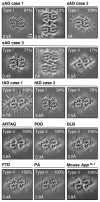Cryo-EM structures of amyloid-β 42 filaments from human brains
- PMID: 35025654
- PMCID: PMC7612234
- DOI: 10.1126/science.abm7285
Cryo-EM structures of amyloid-β 42 filaments from human brains
Abstract
Filament assembly of amyloid-β peptides ending at residue 42 (Aβ42) is a central event in Alzheimer’s disease. Here, we report the cryo–electron microscopy (cryo-EM) structures of Aβ42 filaments from human brains. Two structurally related S-shaped protofilament folds give rise to two types of filaments. Type I filaments were found mostly in the brains of individuals with sporadic Alzheimer’s disease, and type II filaments were found in individuals with familial Alzheimer’s disease and other conditions. The structures of Aβ42 filaments from the brain differ from those of filaments assembled in vitro. By contrast, in AppNL-F knock-in mice, Aβ42 deposits were made of type II filaments. Knowledge of Aβ42 filament structures from human brains may lead to the development of inhibitors of assembly and improved imaging agents.
Conflict of interest statement
Figures




Comment in
-
A molecular view of human amyloid-β folds.Science. 2022 Jan 14;375(6577):147-148. doi: 10.1126/science.abn5428. Epub 2022 Jan 13. Science. 2022. PMID: 35025652
References
-
- Hardy JA, Higgins GA. Alzheimer’s disease: The amyloid cascade hypothesis. Science. 1992;256:184–185. - PubMed
-
- Suzuki N, Cheung TT, Cai XD, Odaka A, Otvos L, Eckman C, Golde TE, Younkin SG. An increased percentage of long amyloid beta secreted by familial amyloid beta protein precursor (beta APP 717) mutants. Science. 1994;264:1336–1340. - PubMed
-
- Scheuner D, Eckman C, Jensen M, Song X, Citron M, Suzuki N, Bird TD, Hardy J, Hutton M, Kukull W, Larson E, et al. Secreted amyloid beta-protein similar to that in the senile plaques of Alzheimer’s disease is increased in vivo by the presenilin 1 and 2 and APP mutations linked to familial Alzheimer’s disease. Nature Med. 1996;2:864–870. - PubMed
Publication types
MeSH terms
Substances
Grants and funding
LinkOut - more resources
Full Text Sources
Medical
Molecular Biology Databases

